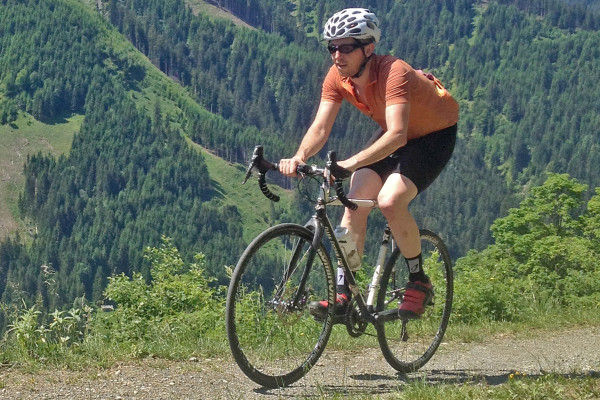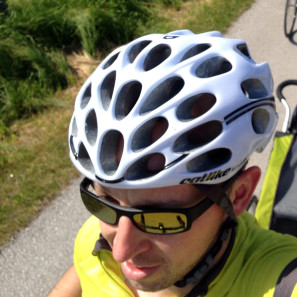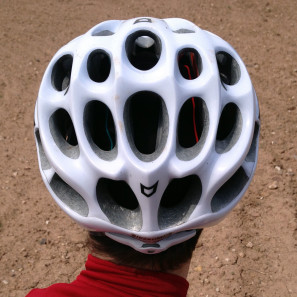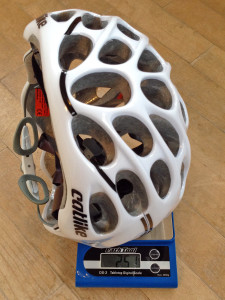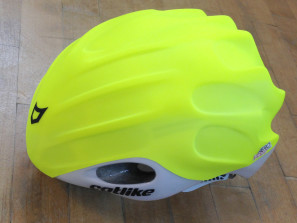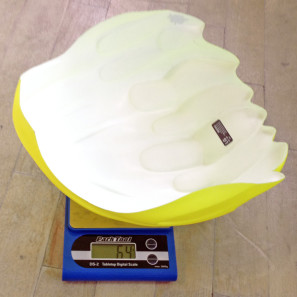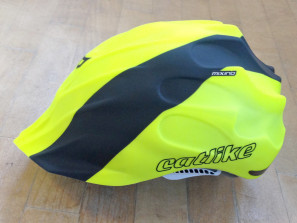We had been eyeing the perforated helmets of Catlike for some time, and after we had a chance to see the latest version of the Mixino road helmet last fall with its removable aero shells we thought it was worth a closer look. As companies moved to introduce aero helmets for road racing, like one or two other companies, Catlike took an interim step and molded two different polycarbonate shells that can be attached to the helmet. The Aero and Rain shells give this helmet a couple extra personalities and a lot more versatility than an aero helmet, or even a typically vented one. We’ve been riding in this helmet for winter through summer now and have been very happy with how it performs in almost all conditions in our long-term test.
Join us after the break for more of our thoughts, actual weights, and pricing…
The Mixino is Catlike’s top of the line helmet, is sold for both road and mountain riding, and will retail for 240€ for the 2016 model. I used it mostly for in between style riding, with several months racing cyclocross and then the entire spring exploring gravel roads and climbing in the mountains. With 23 vents facing forward and 16 letting air out of the back, the Catlike Mixino is certainly a well-ventilated helmet. The helmet sits fairly high on the head, and its deep channels leave a good bit of room on the top of the head for air to move through. It is actually open enough that on clear days with the sun at my back, I could see through the helmet where my shadow hit the ground in front of me, something I’ve never seen on my other helmets. There is also decent coverage down the back of the head for such an open helmet, but its goal is unmistakably lightweight and ventilation not extensive coverage.
With the way the vents taper to the outside of the shell, it looks like there isn’t much foam there, so it’s not too surprising that our large helmet weighed just 251g. What is there is an inmolded EPS foam shell constructed around a graphene fiber reinforced aramid cage in a honeycomb-like shape optimized for overall strength and safety. The inner helmet pads use an Outlast, phase change material to help move heat and moisture away from the head. The MPS EVO fit system includes adjustable temple pad thickness and sliding location, and a height adjustable rear dial to get a comfortable fit. My 58.5cm/23″ head put me right at the low end of the size Large, so the helmet definitely looks fairly big on my head (and I might have been able to actually size down), but a side effect here is that there was more space along the sides of my head so venting even improved.
The Catlike Mixino Shells are simple snap-on covers that broaden the ultra-vented helmet’s usability. They are fit (molded) specifically to this helmet and are size-specific. They have a tight fit and snap into place in a matter of a couple seconds, with a reassuring click once they are properly in place. Once on the fit is firm, and we couldn’t see them coming off unexpectedly, even in a crash. They can actually be a bit tricky to remove, but are flexible enough that it is just a matter of figuring out where to place your fingers and whether going front-to-back or vice versa. I actually took one off as I approached the pit in a cross race when I was overheating too quickly and tossed it to a friend without any trouble. We’ve snapped them off and on at least a couple of dozen times and they feel as tight and secure as the first time.
The Aero Shell is claimed to give an aerodynamic boost while maintaining some ventilation, and we don’t have any reason to think it doesn’t do so. The aero gain isn’t to the degree that it is verifiable in the real world, but it is quiet in the wind which is a good sign, and I will keep thinking that it is helping push me down the road faster. The basic venting does seem to work well up to maybe 15°C, and is noticeably more effective than with the Rain Shell. Over that and I just get too hot and need all the air I can get. The Rain Shell did a pretty good job at blocking heavy rain from hitting me in the eyes, but unless I was on the mountain bike and moving at slow speeds, it wasn’t that big of a benefit. It does work exceptionally well when it is raining heavily and is cold, but realistically we all try to avoid that type of riding. I can really only think of maybe 3 rides in the last year that fit that bill, and its closing off of the exhaust ports even made longer cold weather off-road climbs too hot. Personally I might try to trim the Rain Shell to open up some of the rear venting, but the Aero Shell is pretty close to perfect for what it does.
Both the Mixino Aero Shell and Rain Shell are simple pieces of polycarbonate specially molded to snap onto the Mixino helmets, and retail for 30€ each. The smaller Aero Shell weighs 64g and fits tightly over the base helmet covering all of the front vent openings except two temple vents and leaving the four lower rear vents open. It is available in black, white or the hi-vis yellow that we sampled.
The slightly bigger Rain Shell weighed 78g and has a molded-in visor, which aims to deflect rain off the rider’s face. The Rain Shell’s visor shape allows air into the two lowest vents in the front of the helmet, mostly unrestricted, and to a lesser degree the one front center vent and the two temple vents. It fits tightly across the back of the helmet, closing off all exhaust vents in the rear. It is available in two hi-vis yellow options, including the simple stripe version and one with a black star pattern.
Final Thoughts
Overall, combing the Mixino with the Aero Shell has made this an exceptionally adaptable helmet. In the hottest weather (35°C+) the top of my head stayed cool enough (although did need sunscreen) and the pads kept the sweat on my brow mostly in check. I still ended up sweating a good bit on harder efforts, but my head never felt hot, which is kind of an accomplishment for me. I did very little cool riding with the helmet without the cover, and when I did I always had a cap on underneath. The helmet is airy and borders on cool when the mercury drops.
When the weather would dip below 15°C, it would take just a second to snap on the shell for a bit warmer ride and some bonus aero gains. While the Aero and Rain shells don’t get much use during the warmer summer months, the Aero Shell will probably stay fixed on it from this October though to next spring. I’ve recently become partial to a simple white helmet, so this was nice from an aesthetic side, but I hadn’t truly appreciated the added benefit of being able to change helmet colors with the snap-on shells. Temperatures tend to drop as the days get shorter. The bulk or our autumn and winter riding happens either just around dawn or dusk, or in the proper dark. Having a large His-Vis helmet was a great side benefit, as were the black reflective elements on each shell. I think I will even add a bit more reflective tape to the Aero Shell this winter.
Its combination of light weight, exceptional venting, and the windproof/aero shell have made it my go-to helmet. And it will be a high bar for other helmets to beat for all-around versatility.

